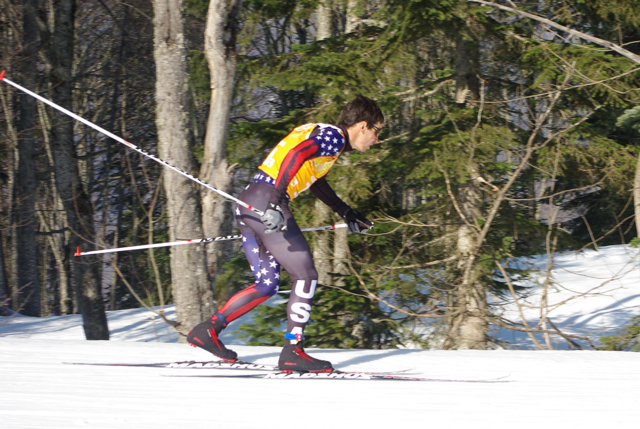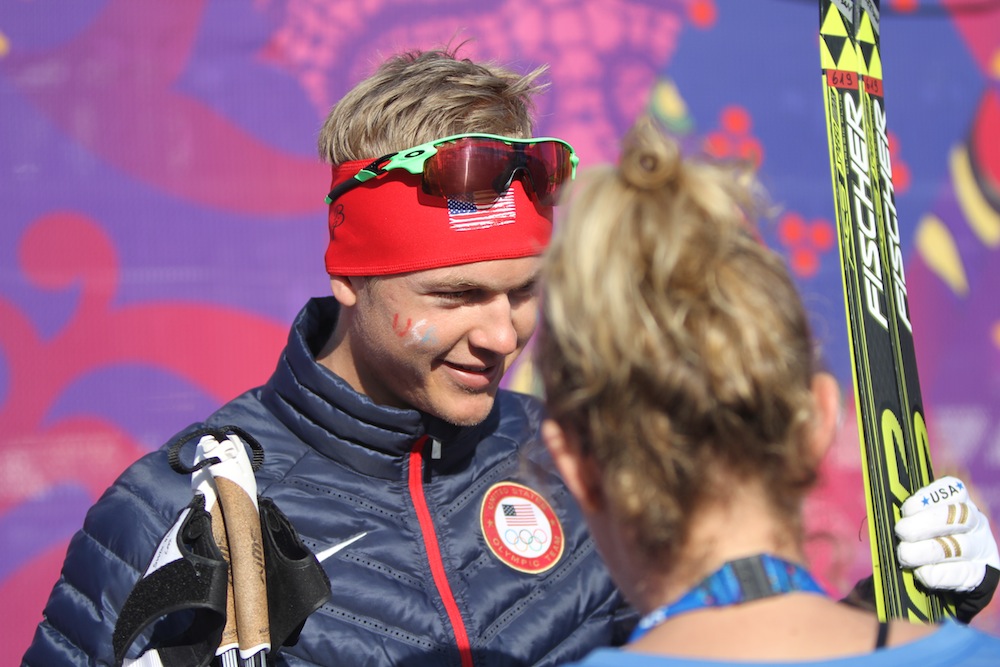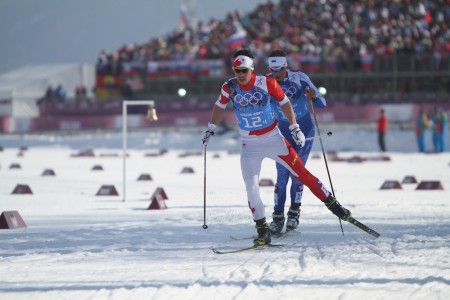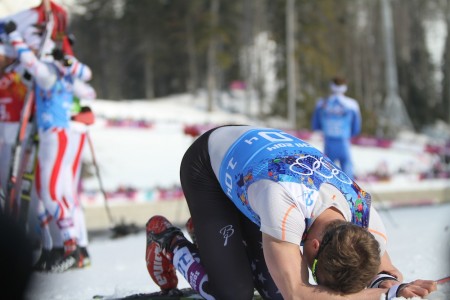
FasterSkier’s coverage is made possible through the generous support of Rudy Project.
SOCHI, Russia – Coming into today’s Olympic 4 x 10 k relay, the U.S. Ski Team men had a goal: to finish in the top eight.
“That’s the goal we have been talking about for the last few years,” Erik Bjornsen said. “We just went into the race today knowing that if things went well, we could really surprise some people.”
Things seemed to start off well, with Andy Newell skiing with the lead pack for eight kilometers and looking strong and relaxed. But then, he bonked severely in the final 1500 meters and lost about a minute to the top teams. After a long gap, Newell came through in 15th place, then collapsed.
“I was just warming up and it seemed like he was in the mix,” said Bjornsen, who skied the second leg of the relay. “I was expecting to be right with them. So I got right out there [in the tag zone], but then I had to wait a little bit.”
For the U.S. team, it was on to plan B – with Noah Hoffman skiing third and Simi Hamilton anchoring, the men finished 11th. It didn’t reach their goal, but the last three skiers (Newell went straight back to the athletes’ village with a doctor and could not speak with the press) all seemed content with their performance.
“It’s a relay, so you never know what is going to happen,” said Hoffman. “We’ve been all over the place with relays. I’ve been tagged close to the lead group and I’ve been tagged a lot further back than today. So you have to be ready to roll with anything and take what’s given to you.”
The remaining men did the best they could, and head coach Chris Grover said he was pleased with the results. Bjornsen had the 11th-fastest time on the second leg while picking off two teams, and Hoffman was the eighth-fastest on the third leg to move into the top ten.
“We were 10th at World Championships last year, so we were kind of about where we have been,” Grover said. “Andy came in on that course about four seconds out of the lead. So if you put that back in and you don’t bleed all that time in the first leg, then we could have been in contact with guys skiing a little bit faster a little bit longer. You never know. I think we would have had a better day.”
When Bjornsen received the tag, he was in no-man’s land, 13 seconds behind Belarus. He tried to stay smart, and not overreact by sprinting to make up the lost spots right off the start.

“The last classic race I went out maybe too hard,” Bjornsen said. “So I was feeling great and I was able to just pop some of those last few hills. I was trying to be realistic and stay smooth so that I could ski a smart race, and I think I did… It’s way easier for me to keep pushing when I know it’s a team event, when I know that I’m pushing for my teammates for every second. So the whole time, I felt like I was fighting out there.”
Hoffman kept that attitude up, passing Kazakhstan, Canada, and Estonia.
He joked: “Any time you can move up, I think it is good – and it is always nice to get ahead of Canada.”
(It goes both ways: “I really just wanted to beat the Americans,” said Canadian anchor Jesse Cockney. “It kind of goes back to the World Juniors relay battle, Canada versus USA.”)
Hamilton took over from there, in only his fourth race of the year longer than five kilometers.
“I wish I had felt a little bit better,” Hamilton said. “I have definitely had good distance races before on courses like this before that are just really rolling and cornery and transitiony… I felt pretty worked the last two kilometers of that, and I don’t know if I could have really jumped the gun in the last 500 meters there.”
Hamilton, a sprinter, had two reasons for racing today. The first was to use the effort as a tune-up for the team sprint on Wednesday, where Hamilton – who won his first World Cup sprint this season in a stage of the Tour de Ski – will team up with Newell. The pair have a good chance at a best-ever result for the U.S.: in 2010, Newell and Torin Koos finished ninth, while in 2006, the first year the event was held at the Olympics, Newell and Chris Cook placed 13th.
In the classic team sprint at the Nove Mesto, Czech Republic, World Cup just one month ago, Hamilton and Newell finished fifth.
“Periods like this when you’re not training a lot, when you’re just doing some maintenance, if you go a bit too long between efforts you

start to feel a little bit flat,” Hamilton explained. “Today was good timing in terms of just in between the sprint and the team sprint. Just go out there and blow out some of the cobwebs that are building up.”
The second reason is that although he currently trains mostly for short distances, Hamilton would like to hold onto that spot as the U.S. anchor for as long as he can. No matter what position he’s in when he receives the tag, it’s good training for the future.
“It’s a cool spot to be in when you’re feeling really good and you’re skiing with some people,” Hamilton said. “When you’re feeling fit and you have trained for it, it’s a great position to be in to be that pressure player and know that you have the speed to get around people in the last part there. I’m hoping that it will stay like that and maybe in a few years we’ll be contending for the podium and I’ll get the chance to do something kind of cool at the end.”
Following the model of Kikkan Randall, who in the last few seasons has collected several exceptional distance results, Hamilton hopes to improve his distance races.
“I’m still hoping that at some point in my hopefully long career, I’ll be able to be up with the best guys and I think it’s just going to take some more work and training hard,” he said.
If he does, he’s starting from a strong position, with two Olympic relays under his belt. With Bjornsen, the youngest member of the U.S. Ski Team, now having one as well, the team is confident that they can keep improving.
“I’m happy with the way I skied, and I’m really impressed with the way Erik skied, and Simi for holding on,” Hoffman said. “It’s a little longer than Simi is used to racing.”
Their coach agreed.
“I haven’t had a chance to see any leg times or anything, but Erik certainly seemed like he was having a great race, Noah was skiing through guys so he seemed like he was having a great race, so there’s some guys putting together some good legs out there,” Grover concluded.
Canada 12th With “B” Relay Team
Early this morning, there were rumors swirling around that Canada would not start the men’s relay. That was patently false.
But it’s true that they didn’t start two of their strongest skiers: Alex Harvey and Devon Kershaw, who will represent Canada in the team sprint on Wednesday.
Instead, Lenny Valjas led off for Canada, skiing into 12th place. Ivan Babikov was able to gain one spot on the next leg, and Graeme

Killick held that position. With the 10th-fastest time on that leg – where the field was blown apart by Johan Olsson of Sweden, and where Alexander Legkov of Russia made a big move to the front – it was probably the best race of the Games for Killick.
Cockney, a sprinter like Hamilton, slid back to 12th in the final leg of the relay.
“I feel okay, at best,” Cockney said after the finish. “I have been stuck in a hotel room for the last three days and sick for the last four. It has been sub-par preparation.”
Cockney started his leg nine seconds behind Hamilton, and was able to cut the deficit in half, but not pass his American rival, which clearly pained him.
Like Hamilton, he relished the chance to anchor the relay and hopes he’ll be in better shape to do Canada proud in the future. Cockney said it was a “no-brainer” to race the relay even though he wasn’t feeling healthy.
“I am thrilled to be racing the relay and the anchor,” he said. “It’s under different circumstances than I expected it to be in my career, but still, it is a really special feeling to be the anchor on a relay at the Olympics… I got a lot of hard work to do to achieve what I want to. But it is motivating, I want to work harder, and I know how hard I do work, so I have a lot of hard work ahead of me.”
-Alex Matthews contributed reporting.

Chelsea Little
Chelsea Little is FasterSkier's Editor-At-Large. A former racer at Ford Sayre, Dartmouth College and the Craftsbury Green Racing Project, she is a PhD candidate in aquatic ecology in the @Altermatt_lab at Eawag, the Swiss Federal Institute of Aquatic Science and Technology in Zurich, Switzerland. You can follow her on twitter @ChelskiLittle.




4 comments
davord
February 16, 2014 at 2:36 pm
First of all, I sincerely hope Newell is ok and there are no long term complications from his race today. Having said that, Grover, you have to put your personal issues with certain skiers aside and be fair with your selection(s). If you were planning on putting Newell and Hamilton in the team sprint, why trash them in the relay? You know full well that these conditions are not the best for these two and neither is the distance, seeing as they are two specialist sprinters. We saw several specialist sprinters ‘bonk’ today, it wasn’t just Newell. Similar things happened to guys like Kozisek, Kreczmer, Valjas and Miyazawa. Once the pace was lifted, Newell was in trouble. I’ve seen this happen to him numerous times before in relays. Why not save these guys for the events that they are going to do much better in? Either that or have two new faces in the team sprint. Give everyone an equal chance. The favoritism and politics within the US Ski Team are almost unbearable.
FlintHillsXC
February 16, 2014 at 3:23 pm
I know zero about internal U.S. ski team politics, and even less about each of our skiers’ fitness at any given moment, but I did have a similar thought: who not rest Newell so that the U.S. would have an outside chance to medal in the team sprint? Of course, the relay is a hugely important event, closely following throughout the skiing world — so one can also make a reasonable case that we were right to do everything we could to put on a good relay showing. It’s too bad Freeman wasn’t even skiing at 2012-13 levels … like the women’s team, the men just really need one more viable classic distance skier for the relays.
Separately, I am surprised more people are not talking about the racing suits. Um, we all knew that the weather in Sochi was going to be a joke, so even if Black was the chosen color, why was the team not ready with some sort of biking short/cut-off racing suit suitable for these subtropical, global warming Games? And the women should have come ready with an official racing sleeveless top or sports bra.
nicktrautz
February 16, 2014 at 8:31 pm
I think the idea was to use this effort to sharpen Newell and Hamilton for the team sprint, not to compromise them. They have been out of the races for quite a few days and don’t need to be sharp until Wednesday, so the 10K effort is nicely placed here, training wise (presuming they wouldn’t have a medical problem…). I hope there’s no serious problem with Andy and that they both get the training response from the effort.
Tim Kelley
February 16, 2014 at 8:35 pm
FlintHillsXC: If the 30/50 is hot, the USST has the racing suit issue covered. All it takes is a pair of scissors. You probably saw a picture of Sundby racing with a short-sleeve racing suit His ragged sleeve ends showed he just hacked off the arms with scissors. Racing tights can be turned into racing shorts in 10 seconds if need be.